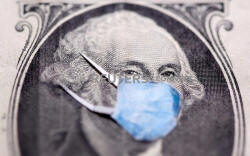Dollar consolidates gains at 2-month highs on economic
concerns
 Send a link to a friend
Send a link to a friend
 [September 24, 2020] By
Saikat Chatterjee [September 24, 2020] By
Saikat Chatterjee
LONDON (Reuters) - The U.S. dollar held at
a two-month high on Thursday as investors sought its safe-haven appeal
on growing concerns over the resilience of an economic recovery in the
United States and Europe amid a second wave of coronavirus infections.
Federal Reserve policymakers called on the U.S. government to provide
more fiscal support, fuelling a bout of selling in risky assets
overnight, while European economic data has worsened in recent days
prompting investors to lighten their positions after a rally in August.
"Safe haven demand and higher inflation adjusted yields is leading to a
mini dollar revival," said Kenneth Broux, a strategist at Societe
Generale in London.
Against a basket of six other currencies <=USD>, the dollar edged up
0.1% to a two-month high at 94.56. It is up nearly 2% so far this week
as economic momentum shows signs of fading. It fell to an April 2018 low
of 91.8 at the end of August.

Appetite for riskier assets soured after data on Wednesday showed U.S.
business activity slowed in September and new restrictions to stem a
surge in coronavirus infections in Europe hit the services industry.
The Norwegian and the Swedish crown came under particular selling
pressure in London trading hours after the former trimmed its inflation
forecasts for the next year and said no rate hikes are planned for now.
The crown weakened 0.8% versus the euro to a 4-1/2 month low of 11.15
crowns <EURNOK=D3>, and 0.9% versus the U.S. dollar to a near
three-month low of 9.6 crowns, before trimming some losses.
The Swedish crown <SEK=D3> fell 1% against the greenback to 9.07 crowns
per dollar.
A surge in COVID-19 cases in Europe risks becoming a deadly double
epidemic of flu and coronavirus infections, EU health officials warned
on Thursday as they urged Europeans and their governments not to let
their guard down.
[to top of second column] |

George Washington is seen with printed medical mask on the one
dollar banknote in this illustration taken, March 31, 2020.
REUTERS/Dado Ruvic/Illustration

Also puncturing market optimism are growing concerns that U.S.
policymakers might struggle to reach an agreement to push for more
fiscal stimulus after the November elections.
"Optimism on the recovery, optimism on the virus, and bets on stimulus
were keeping markets well bid, and on all three of these issues, there
has been a degree of disappointment this month," said John Velis, an FX
and macro strategist at BNY Mellon.
U.S. Federal Reserve Vice Chair Richard Clarida said on Wednesday that
the U.S. economy remained in a "deep hole" of joblessness and weak
demand and called for more fiscal stimulus, adding that policymakers
"are not even going to begin thinking" about raising interest rates
until inflation hits 2%
Some investors are also watching the Australian and New Zealand dollars,
which have come under pressure on growing expectations their central
banks could deliver more monetary stimulus. A decline in commodity
prices is expected to increase downside risks for both currencies.
The Aussie <AUD=D3> fell 0.45% to $0.7042, near its weakest since July
21.
Other safe-haven currencies, including the Japanese yen <JPY=EBS> and
the Swiss franc <CHF=EBS>, also held firm.

The British pound <GBP=D3> oscillated between gains and losses but held
above $1.27 before an announcement of Britain's plans to protect jobs
and employment later in the day.
(Reporting by Saikat Chatterjee; Editing by Kirsten Donovan)
[© 2020 Thomson Reuters. All rights
reserved.] Copyright 2020 Reuters. All rights reserved. This material may not be published,
broadcast, rewritten or redistributed.
Thompson Reuters is solely responsible for this content. |